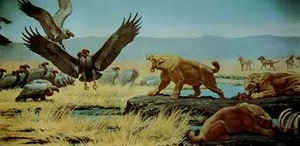Nebraska State Fossil
Mammoth

(Elephas primigenius)
Adopted on March 1, 1967.
The mammoth, (Elephas primigenius,) officially became Nebraska's state fossil with a bill passed by the Legislature on Nebraska's 100th birthday, March 1, 1967. The world's largest Mammoth skeleton was found in Lincoln County, Nebraska; nicknamed "Archie." This extremely large Mammoth is on display in the University of Nebraska State Museum.
Nebraska State Fossil: Mammoth

The mammoth was a common inhabitant of northern Europe and Asia during the Pleistocene Age. Various species of the mammoth crossed the Bering Strait land bridge and spread throughout most of North America. Mammoths were elephants, but some were larger than the modern elephant. Early prehistoric people hunted the mammoth and found the animal's ivory tusks useful in making tools and realistic etchings. Mammoth remains have been found in most Nebraska counties. One mammoth found in Lincoln County, Archidiskodon imperator maibeni, was one of the world's largest elephant fossils. It is displayed in the University of Nebraska State Museum in Lincoln.
Although the mammoth was an elephant, it was much larger than the modern elephant. The three main species that have been found in Nebraska are the Elephas primigenius, the Elephas columbi or Columbian elephant, and the Elephas imperator or Imperial elephant. Elephas primigenius had a coat of long, shaggy hair to protect it from the extreme cold of the north, and its remains are seldom found south of Nebraska. The largest, the Imperial elephant (sometimes reaching heights of 13 to 14 feet), and the Columbian elephant roamed west of the Mississippi from Nebraska to northern Mexico. Both are thought to have adapted to life on the open plains and probably had coats of hair lighter and shorter than Elephas primigenius. Tusks of the Columbian elephant curved downward first, the upward and inward. The tusks' tips crossed when the elephant was full-grown.
Early prehistoric man hunted the mammoth with primitive weapons like spears and javelins. He found the animal's ivory tusks more useful than bone for many purposes and used it in making tools and realistic etchings. Fossilized ivory has been found in Nebraska, but it is of little commercial value as groundwater and soil acids have altered it composition.
Mammoth remains have been found in most Nebraska counties. One mammoth found in Lincoln County is reportedly the world's largest elephant. Displayed in the University of Nebraska State Museum in Lincoln, this mammoth, Archidiskodon imperator maibeni, was believed to have roamed the plains in the late Pleistocene period.
Source: Nebraska Bluebook, 1994-95, pg. 28.
Nebraska Revised Statute
The law designating the mammoth as the official Nebraska state fossil is found in the Nebraska Statutes, Chapter 90 (Special Acts) Section 90-109.
Chapter 90 Special Acts
90-109. State fossil; mammoth.
The mammoth is hereby designated as the official state fossil.
Source
Laws 1967, c. 609, § 1, p. 2057;
R.R.S.1943, § 84-726.
Taxonomic Hierarchy: Mammoth
Kingdom: Animalia
Phylum: Chordata
Class: Mammalia
Order: Proboscidea
Family: Elephantidae
Genus: Mammuthus
Species:
Synonyms
Elephas primigenius Blumenbach, 1799
Mammonteus primigenius (Osborn, 1924)
Elephas boreus Hay, 1924
Mammuthus boreus (Hay, 1924)

Some states that lack a "state fossil" have nevertheless singled out a fossil for formal designation such as a state dinosaur, rock, gem or stone.







